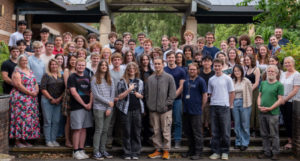Beeswax: a natural and sustainable way to harvest energy from sound

Beeswax could one day be used to harvest energy from sound, thanks to new research from the University of Exeter
Beeswax could one day be used to harvest energy from sound, thanks to new research from the University of Exeter.
A new paper, published in Nano Energy, outlines a new way of using the natural and widely-available material to convert mechanical energy into electrical energy.
The new development – known as textile triboelectric nanogenerators – could also generate electrical energy from other mechanical stimuli, such as vibration, touch and rubbing. It unlocks the untapped potential of beeswax in the realm of electronics and opens new possibilities to address the current energy challenge. The unique properties of bees wax could mean that one day, textiles could harvest the noise from their surroundings and turn it into energy.
It has long been though that such devices could lead to the development of cutting-edge technologies that could have a transformative impact in the fields of healthcare, environmental sciences, space exploration, communication and defence. However, until now, solutions were lacking on efficient, low-cost, and environmentally friendly ways to design and make the nanogenerators.
The new study, funded by the UK Engineering and Physical Sciences Research Council (EPSRC) via their Adventurous Manufacturing engineering research, presents a novel approach to this challenge by using beeswax as the active electronic material for the nanogenerators. The team shows that beeswax, has a unique combination of properties that make it an ideal candidate for energy-harvesting and sensing textile technologies. These properties are related to the way it conducts electricity, its shape and structure, and how it behaves when subjected to mechanical stress.
Beeswax is a natural raw material that requires little post-processing. The study also reveals the self-healing and self-cleaning properties of beeswax, which enable the nanogenerators to function effectively even in high levels of humidity and mechanical bending which are common in real-life applications, especially in wearable technology. This is because they need to provide comfort and reliability for the users, who may sweat, wash, or expose their devices to different environments. They also need to conform to the body movements and perform efficiently even when bending and flexing the fabrics.
Moreover, the study demonstrates that the nanogenerators can not only harvest energy from sound pollution, such as ambient noise and human voice, but also act as self-powered microphones that can detect and differentiate between different voices and emotions. This finding opens new possibilities for voice recognition and emotion detection systems that can be embedded within textiles.
Furthermore, the study explores the potential of the nanogenerators as acoustic hybrid energy harvesters, capable of converting both acoustic pollution and mechanical vibrations, such as those generated by working mechanical engines, into practical electrical energy.
Dr Evgeniya Kovalska, first author of the paper from the University of Exeter’s Engineering Department, said: “Our research represents a significant step forward in the development of sustainable, low-cost, and accessible energy-harvesting textiles with minimal environmental impact. The implications of this work extend across various industries, promising transformative advancements in the integration of self-powered sensing technologies into everyday fabrics.”
Professor Monica Craciun, from the University of Exeter’s Engineering Department, who led the work said: “Textiles equipped with nanogenerators that convert the sounds from conversations into electrical energy open up innovative possibilities for sustainable energy. Imagine sitting in a bustling restaurant or café where the textiles around you, such as curtains, have sound-harvesting technology embedded in them. When people talk, the devices capture sounds from their voices and convert them into electrical power, providing a local and green energy source. This idea is in line with the growing interest in ambient energy harvesting, where power is generated from everyday activities for various purposes..”
Professor Saverio Russo, a co-author of the paper from the University of Exeter’s Physics Department, also pointed out that: “Industrial machinery, such as pumps and compressors, generates low-frequency sounds and vibrations that are often regarded as noise pollution. However, this noise can also be a source of renewable energy if it is captured and converted into electrical power. This is the idea behind one of the applications presented in our paper. These textile nanogenerators could be strategically placed in an industrial setting where numerous machines operate simultaneously and collect the noise produced by them. Instead of wasting this energy, the nanogenerators can transform it into a renewable power source. The potential applications range from powering on-site sensors and monitoring systems to contributing to the facility’s overall energy needs, making industrial processes more sustainable and efficient..
The full paper, titled “Textile Beeswax Triboelectric Nanogenerator as Self-Powered Sound Detectors and Mechano-Acoustic Energy Harvesters by E. Kovalska et al”, is available online .



